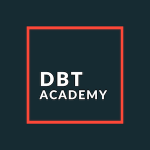How to Train in DBT: 8 Best Courses and Online Programs
 Sometimes experimentation and error can lead to a wonderful discovery.
Sometimes experimentation and error can lead to a wonderful discovery.
That is how many great innovations came about.
Did you know that Dialectical Behavior Therapy (DBT) intervention was a trial-and-error attempt (Linehan, 1987)? Since its creation, research has revealed many interesting facts about DBT.
Clients who receive 20 sessions of DBT skills training show a significantly stronger symptom reduction than those who do not receive the treatment (Kramer et al., 2016).
Other research has found brain changes, reduced amygdala activation, and reduced emotion dysregulation in clients who have received DBT (Goodman et al., 2014).
Sounds interesting, right? Are you interested enough to try this specialized treatment for clients? If so, read on to learn about DBT programs, courses, and online training.
Before you continue, we thought you might like to download our three Positive Psychology Exercises for free. These science-based exercises explore fundamental aspects of positive psychology, including strengths, values, and self-compassion, and will give you the tools to enhance the wellbeing of your clients, students, or employees.
This Article Contains:
Training in DBT Explained
Linehan (1993a) developed the model for Dialectical Behavior Therapy (DBT) from biosocial theory, which recognizes that borderline personality disorder (BPD) is a pervasive disorder of the emotional regulation system. Linehan (1993a, 1993b) also adopted the philosophical concept of dialectics, synthesizing oppositions.
Linehan (1993b) compiled a treatment manual that focused on chronically suicidal individuals who also met the diagnosis for BPD (Linehan, 1987, 1993a).
There are a specific set of principles involved in the Dialectical Behavior Therapy treatment process, and the following main points and considerations are adapted from an online DBT course by Psychotherapy Academy (Vaughn, 2021).
- Standard DBT involves a pre-treatment period. This may be two to three sessions, and you will need to work with your client to formulate a DBT plan. You will need to explain the difference between DBT and other standard therapies.
A typical DBT agreement between the therapist and client covers at least one year.
Another significant part of the agreement is that any self-harm or attempted suicides will result in clients being taken off treatment for a while. This will all need to be explained within the first two to three sessions.
- You will need to be trained in the provision of individual therapy. Weekly individual sessions are undertaken. Diary cards, behavioral chain analysis, prioritizing targets, formal assessments (such as the Linehan Risk Assessment Protocol), and data tracking are all included in individual sessions. Familiarity with these is essential.
- Group session training, which is the essential next component, takes place after individual sessions. Groups typically contain 3–10 individuals, and sessions last around 1.5–2.5 hours. There are at least four modules to cover with clients, including mindfulness.
- The next component is intersession contact between the therapist and patient. This may be through online therapy platforms or teletherapy. The client will have your cell number, but you will need to set healthy boundaries and limits with clients, as these can be easily violated. You will also need to understand and be well versed in therapy interfering behaviors.
- Last but not least are peer consultation team meetings. These weekly meetings last for one to two hours. You will consult with other professionals who are treating the client. The purpose of these meetings is to support each other and the client. This forum allows the discussion of cases and application of DBT principles, reinforcing DBT practices.
3 DBT Certification Programs

This is illustrative of the popularity of this chosen intervention route for treating highly intense emotional difficulties.
DBT interventions can be provided by different types of mental health professionals: psychiatrists, psychologists, social workers, therapists, counselors, occupational therapists, teachers, clergy, and anyone working with children and adolescents with challenging behaviors.
Some health professional courses may have DBT as an optional topic embedded within the main program. Other health professionals who have not undertaken DBT training may wish to top up their skill set by training in DBT. One prerequisite for these courses is at least some prior mental health knowledge.
Outlined below are certified DBT programs in the United States and United Kingdom that offer thorough training in this intervention.
1. DBT-Linehan Board of Certification, USA
The DBT-Linehan Board of Certification provides a professional certification program in adherence with the model developed by Dr. Linehan (1987).
Many certified clinicians and programs run under the umbrella of DBT-Linehan across the United States. You can search on their website to find an accredited clinician or program near you.
The assessments in DBT test the application of knowledge to the performance and delivery of the treatment. The course also provides accreditation.
Learn more on the DBT-LBC website.
2. Adult DBT Skills Courses – DBT Academy, USA
The DBT Academy offers adult DBT skills courses that cover emotion regulation, distress tolerance, and interpersonal effectiveness.
The courses may be completed in any order and provide essential knowledge and learning to gain skills required to practice DBT with adults.
Completion of all three courses will take about six months. In order to be considered a graduate of DBT, students must attend each module twice. Following on from this, students gain eligibility to attend the advanced skills DBT courses.
The DBT skills classes meet weekly, covering the basic skills required for DBT, and are taught by qualified instructors.
The three courses are listed below:
Emotion regulation
This nine-week course provides information on how clients may understand their emotions, form healthy habits, increase their self-control, and decrease their suffering.
Distress tolerance
This eight-week course provides information on helping clients to regain control, relax and soothe themselves, cope with difficult emotions, and accept what cannot be changed.
Interpersonal effectiveness
This seven-week course provides information on supporting clients as they learn how to ask for what they need, say ‘no,’ build healthy relationships, and reduce conflict.
Learn more on the DBT Academy website.
3. Extended Training in DBT – The Association for Psychological Therapies, UK
The Association for Psychological Therapies (APT) is a leading provider of accredited DBT training courses in the United Kingdom and Ireland for professionals working in mental health and allied work areas.
APT provides a 10-day course entitled Extended Training in DBT. This is a comprehensive training in DBT, and it is accredited to Level 4 if you complete the relevant exams and the masterclass components.
They provide this course face-to-face or online. It covers individual therapy, group work, intersession contact, and peer consultation. Each delegate is provided with the DBT manual by Linehan (1993b).
Learn more on the APT website.
5 Courses and Online Options
Further to the programs mentioned previously, there are other options as well, and online courses are becoming increasingly popular.
1. DBT in Practice: Mastering the Essentials – Psychotherapy Academy, USA
Psychotherapy Academy provides self-paced online DBT training covering all the essentials of DBT.
The course is delivered by Stephanie Vaughn (2021), PsyD, a DBT provider and trainer.
This course has easy-to-watch videos and is fun to follow. The training offers up to 5.25 continuing education credits. It is suitable for physicians, nurses, psychologists, counselors, social workers, and addiction specialists.
The training covers DBT fundamentals, skills training groups, individual therapy, and the importance of intersession contact. It also helps identify and address interfering behaviors and the role of dialectical dilemmas.
Learn more about this course from the Psychotherapy Academy website.
2. DBT in a Nutshell: Treating Multi-Diagnostic Complex Individuals – Portland DBT Institute, USA
The Portland DBT Institute offers basic through advanced courses in DBT. The trainer, Dr. Linda Dimeff, developed DBT for substance users. This is an online course.
The two-day DBT fundamentals course is a good starting point for DBT training. The course is designed for all types of mental health professionals, including teachers and clergy.
The courses provide information about the basics of DBT treatment, emerging research, DBT skills, validation, and dialectics.
Learn more about this course from the Portland DBT Institute website.
3. Diving into DBT Skills: An Overview of the New and Old DBT Skills – Portland DBT Institute, USA
Diving into DBT Skills is an excellent follow-up course to DBT in a Nutshell. It emphasizes new DBT skills.
It also describes the latest research findings, mindfulness, and states of mind; lists distress tolerance skills; and defines DBT skills.
Learn more about this course from the Portland DBT Institute website.
4. Running DBT Skills-Development Groups – The Association for Psychological Therapies, UK
Running DBT Skills-Developmental Groups is a three-day course offered face-to-face or online for individuals or teams.
The course will show you how to run skills-developmental groups. The specific aspects of this group training incorporate mindfulness, interpersonal effectiveness, emotional regulation, and distress tolerance. You may wish to engage in specific elements of DBT if you already have some background training in DBT.
Each delegate is expected to run a group with another delegate and receive constructive feedback on performance.
Learn more about this course from the APT website.
5. Various Training Options – British Isles DBT Training, UK
Established for over 25 years, the British Isles DBT Training offers a selection of on-site courses.
Training options include Foundational Training, Essential Skills, Regulating Emotion, Intensive Training and much more.
Specialist courses include Skills & Strategies for Front-line staff, and also a course regarding adapting programs for dysregulated and suicidal teens.
As a practitioner, you will wish to know the best practices for assessing and managing suicide risk.
This course familiarizes students with chronic and acute factors of risk and also protective factors. Professionals will learn how to screen for risk and speak to and manage clients who are suicidal. You will also learn about working within guidelines to manage risk and intervene to prevent suicide through the Linehan Risk Assessment and Management Protocol (Linehan, 1993b).
Learn more about this course from the British Isles DBT Training website.
What a Dialectical Behavior Therapy (DBT) session looks like – MedCircle
A Look at Mindfulness X Training
Mindfulness is the backbone of DBT (Lothes et al., 2021). It is a core skill that can help the client pay attention to the present. It helps focus attention on the present experience so that the client is not lost in the past or thinking about the future (Bishop et al., 2004).
Mindfulness is an excellent way to step back and notice what is happening so you don’t get caught up in out-of-control emotions (Bishop et al., 2004) or continuously run on autopilot (Kabat-Zinn, 1990).
Although autopilot can be helpful if you want to get things done quickly, problems can arise if you are on autopilot most of your life and not present in the moment (Kabat-Zinn, 1990).
The provision of mindfulness to clients within DBT must be undertaken properly, and a mindfulness masterclass will provide you with the methodology for mindfulness training.
Mindfulness X is an eight-session mindfulness training package created by Dr. Hugo Alberts, a psychologist and researcher. Training in this program allows you to teach mindfulness practices confidently and safely, since it is a science and practice-based method to use with clients.
In this masterclass, you will be taught how to deliver the training effectively to your client, either individually or as part of a group, and manage any obstacles along the way. As part of the information pack, you will find a train-the-trainer course to equip you with all the confidence you need to get started.
The techniques learned from this program must be applied to the mindfulness aspect of a DBT training intervention. You will be able to deliver high-quality mindfulness training to your clients who may be experiencing highly intense emotions.
The package contains the eight most important pillars of mindfulness, an instruction manual, a PDF workbook to use with your clients, and PowerPoint presentation slides. Also included are expert-guided meditations and 11 other science-based exercises. A certificate template will reward clients and help them track their improvements.
You can learn more here about Mindfulness X training.
Resources From PositivePsychology.com
You can use several resources with your clients to form part of a DBT intervention.
17 Positive psychology exercises
Individuals who experience highly intense emotions often compare themselves to others and criticize their flaws (Morey, 2014).
We have fantastic science-based tools you may wish to purchase and use in your sessions to assist your clients with coping skills, communication, optimism, and mindfulness. There is practical advice and detailed descriptions of how to use these positive psychology tools in the exercise pack.
Emotion Regulation Worksheet for Adults
Clients who require DBT interventions are often experiencing intense emotions, including suicidal ideations (Linehan & Nielsen, 1981).
This free worksheet can help clients explore their emotional reactions to situations in their lives and reflect on the repercussions.
3-Step Mindfulness Worksheet
This free worksheet takes the client through three steps to bring awareness of the present moment. This worksheet can be used when a formal mindfulness practice is not practical.
The three steps are simple enough for most clients to engage with and involve becoming aware by thinking and sensing in the moment.
Breathing in and out is another step to help clients anchor themselves. Awareness of physical sensations inward and then letting awareness expand outward is the last easy step.
Linking Feelings and Situations
Individuals who experience intense emotions often struggle to link thoughts and feelings with the context (Carpenter & Trull, 2013).
This free and straightforward worksheet can help clients identify past situations with intense feelings (negative and positive). The client will be able to explore their feelings and link them to their thoughts.
Assess Barriers to an Accepting Attitude
DBT therapy requires the therapist to synthesize radical acceptance of the past and present with realistic limitations on the future (Linehan & Wilks, 2015).
This free worksheet helps practitioners reflect on barriers they may have experienced in accepting their clients and how they may change this in the future. It examines the thoughts and beliefs of the practitioner and is a worksheet for self-reflection. It should not be shared with the client.
A Take-Home Message
DBT may be ideal as an intervention for individuals experiencing intense emotions and may not be suited to low-intensity therapies.
As such, DBT training has a specific training regime. This article provided information about certification programs, courses that include online options, and more information on mindfulness training.
We hope this article has interested you enough to consider training to enhance your skill set and confidence to include clients with BPD or others with heightened mental health difficulties.
If you decide to do so, you will be providing a beneficial service to those who need your assistance.
We hope you enjoyed reading this article. Don’t forget to download our three Positive Psychology Exercises for free.
- Bishop, S., Lau, M., Shapiro, S., Carlson, A. N., Carmody, J., Segal, Z., Abbey, S., Speca, M., Velting, D., & Devins, G. (2004). Mindfulness: A proposed operational definition. Clinical Psychology: Science and Practice, 11(3), 230–241.
- Carpenter, R. W., & Trull, T. J. (2013). Components of emotion dysregulation in borderline personality disorder: A review. Current Psychiatry Reports, 15(1), 335.
- Goodman, M., Carpenter, D., Tang, C. Y., Goldstein, K. E., Avedon, J., Fernandez, N., Mascitelli, K. A., Blair, N. J., New, A. S., Triebwasser, J., Siever, L. J., & Hazlett, E. A. (2014). Dialectical behavior therapy alters emotion regulation and amygdala activity in patients with borderline personality disorder. Journal of Psychiatric Research, 57, 108–116.
- Kabat-Zinn, J. (1990). Full catastrophe living: Using the wisdom of your body and mind to face stress, pain, and illness. Hyperion.
- Kramer, U., Pascual-Leone, A., Berthoud, L., de Roten, Y., Marquet, P., Kolly, S., Despland, J. N., & Page, D. (2016). Assertive anger mediates effects of dialectical behaviour-informed skills training for borderline personality disorder: A randomized controlled trial. Clinical Psychology & Psychotherapy, 23(3), 189–202.
- Linehan, M. M. (1987). Dialectical behavior therapy for borderline personality disorder. Theory and method. Bulletin of the Menninger Clinic, 51(3), 261–76.
- Linehan, M. M. (1993a). Cognitive behavioral therapy of borderline personality disorder. Guilford Press.
- Linehan, M. M. (1993b). Skills training manual for treating borderline personality disorder. Guilford Press.
- Linehan, M. M., & Nielsen, S. L. (1981). Assessment of suicide ideation and parasuicide: Hopelessness and social desirability. Journal of Consulting and Clinical Psychology, 49(5), 773–775.
- Linehan, M. M., & Wilks, C. R. (2015). The course and evolution of dialectical behavior therapy. American Journal of Psychotherapy, 69, 97–110.
- Lothes, J. II, Mochrie, K., Wilson, M., & Hakan, R. (2021). The effect of DBT-informed mindfulness skills (what and how skills) and mindfulness-based stress reduction practices on test anxiety in college students: A mixed design study. Current Psychology, 40, 2764–2777.
- Morey, L. C. (2014). Borderline features are associated with inaccurate trait self-estimations. Borderline Personality Disorder and Emotional Dysregulation, 1, 4.
- Vaughn, S. (2021, October 5). The structure of standard DBT: The 4 skill modules. Psychotherapy Academy. Retrieved January 10, 2022, from https://psychotherapyacademy.org/dbt/structure-of-standard-dbt/
Read other articles by their category
- Body & Brain (49)
- Coaching & Application (57)
- Compassion (26)
- Counseling (51)
- Emotional Intelligence (24)
- Gratitude (18)
- Grief & Bereavement (21)
- Happiness & SWB (40)
- Meaning & Values (26)
- Meditation (20)
- Mindfulness (45)
- Motivation & Goals (45)
- Optimism & Mindset (34)
- Positive CBT (28)
- Positive Communication (20)
- Positive Education (47)
- Positive Emotions (32)
- Positive Leadership (18)
- Positive Parenting (4)
- Positive Psychology (33)
- Positive Workplace (37)
- Productivity (16)
- Relationships (46)
- Resilience & Coping (36)
- Self Awareness (21)
- Self Esteem (38)
- Strengths & Virtues (32)
- Stress & Burnout Prevention (34)
- Theory & Books (46)
- Therapy Exercises (37)
- Types of Therapy (64)










